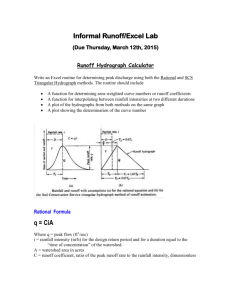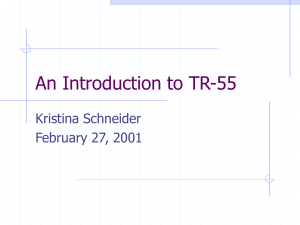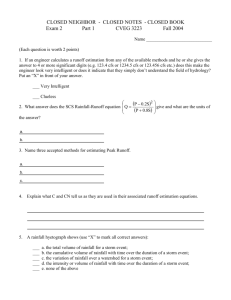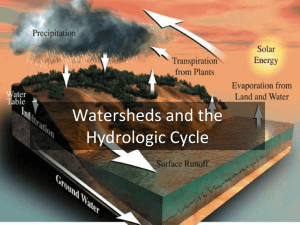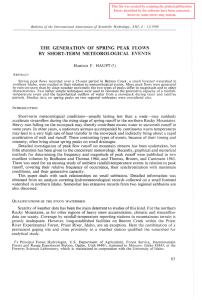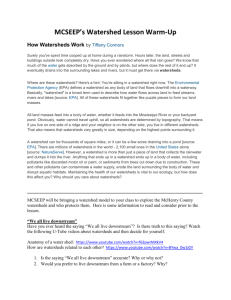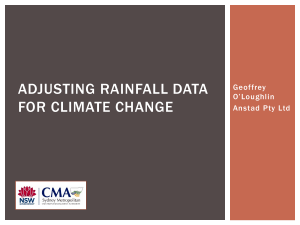Lecture 5 - Water Budget 3: Stream Flow
advertisement
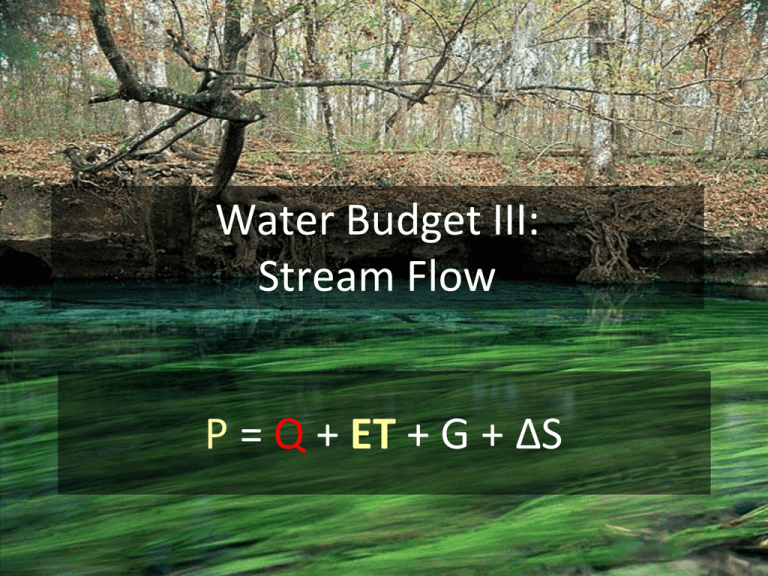
Water Budget III: Stream Flow P = Q + ET + G + ΔS Why Measure Streamflow? • Water supply planning – How much water can we take out (without harming ecosystems we want to protect) • Flood protection – How much water will come down the channel if X storm happens? Who’ll be flooded? • Water quality – What are the fluxes (flow x concentration) of contaminants to a lake or estuary? • What are the effects of land use change on water delivery to downstream systems? Stream Flow Network (http://water.usgs.gov) Extreme Low Flows Rainfall between Oct 1. 2010 and January 21, 2011 is 2.68 inches Hydrograph- graph of flow over time Flow Over Time – Santa Fe River Seasonality of Flow Watersheds as Filters • Rain falls • Storages “buffer” the rainfall signal, letting water out slowly – More storage = more buffering • The result is that the rainfall signal looks stochastic, the flow looks more “organized” • Watershed properties AND size affect the filtering effect Rainfall Filtering – Santa Fe River Rainfall Filtering – Finer View Consider the “Filter” Effects of: • • • • • • • Watersheds with steep vs. shallow slopes Watersheds with deep vs. shallow soils Watersheds with intense vs. extended rainfall Watersheds with forests vs. parking lots Watersheds with dams vs. not Big vs. little watersheds Watersheds with big shallow aquifers Basin Filtering Creates Lags – Hatchet Creek Where is Stream Flow From? • At any time, flow is a composite of water with different sources and residence times – Some water is stored in the watershed for a very long time, some very short – During low flow conditions, water is mostly old – During storms, the contribution of new water increases – How does an aquifer affect this? 2% 8% 23% Flow and Rainfall Intensity • If Rainfall Intensity > Infiltration Capacity then surface runoff occurs • Stream flows are composites of – Surface runoff – Subsurface flows Variable Source Area (Stormflow Generation in Florida) Variable Source Area Makes Antecedent Rainfall IMPORTANT Land Use (Cover) Affects Runoff Generation • Impervious surfaces preclude infiltration • Less infiltration means more runoff • Runoff also MOVES faster – Less “filtering” • Compare land uses… More stormflow, higher peak flow, sooner. Forest Ag Urban The importance of storage – the basis of filtering Same total flow (area under the curve), lower peak flow. Water Storage in the Forest Wetland Hydrological Services Depressions and vegetation (swamps) slow runoff. Upper watershed wetland storage delays runoff and reduces peak flows. Wetland flood plain has a dominant influence on downstream peak flow and solute transport. Why Does Storage Matter? 3 200,000 m of Stormwater Runoff; 3 Channel Peak Flow capacity of 1m /s All in one day 3 Peak Flow =2.3 m /s Spread over 3 days 3 Peak Flow = 0.8m /s How Big a Flood Can We Expect? • The size of the flood is inversely proportional to it’s frequency – – – – Big event happen rarely Big events shape the landscape Medium events maintain the landscape Small events control the biology • How would we predict the size of a flood that happens roughly once in 25 years? – Think back to the rainfall lab… Rainfall Recurrence Series Flow (Santa Fe River Station 3) Daily Flow Recurrence Series The 100-yr Floodzone Map How Do We Measure Streamflow? • Funny you should ask…basis of Lab #4. • Basis is to estimate: – Cross-sectional area (A; through which water flows) – Water flow velocity (V) • Q=A*V Measuring Surface Flow Typical stream velocity profile Where to measure mean velocity? Float Velocity * 0.8 for natural channels Float Velocity * 0.9 for concrete channels Velocity Instruments $2k Turn-cup 0.500 ft/s $4k $7k Electromagnetic 0.050 ft/s Sonic Doppler 0.005 ft/s Sect Width (m) Depth (m) 1 2 1 1 0.7 2.0 Vel@.6 Flow m/s (m3/s) 0.20 0.14 0.25 0.50 3 Total 1 1.3 0.15 0.20 0.84m3 /s Discharge is HARD to Measure • We want: – Daily (or sub-daily) measurements – Multiple stations per river – Real time updating (detect changes in flow as they are happening) Rating equations (stage vs. discharge) allow continuous flow monitoring Stage-Discharge Relation • Water stage (elevation) is EASY to measure • Stage is related to dischage via a mathematical relationship • Applying that relationship to measured stage gives estimates of discharge H H t Stage Hydrograph Q Q Stage-Discharge Curve or Rating Curve t Discharge Hydrograph Stage-Discharge Relation • Typical relationship: Q = a(H +b)c • The relationship between H & Q has to be calibrated locally for different stations • At low stage, positive relationship between stage and discharge • At high stage, negative relationship • Why? Discahrge Stage Discharge Relationship for the Ichetucknee River Stage Stage Measurements Float-pulley Staff gage Pressure Ultrasonic Weirs Flumes Weir vs Flume Type The Good The Bad Weir Low cost Easy installation Won’t work on low gradient streams Upstream flooding Clogs Changes WQ Wildlife barrier Flume Works ok in low gradient streams Better for WQ and wildlife Self cleaning High cost Difficult to install What if there’s no rating curve? • New watershed, new conditions • Areas where it’s hard to develop rating curves – For example, the Everglades Manning’s Equation - Flow Estimation without a rating equation Q= 1/n * A * r 2/3 * s1/2 Q = estimated flow m3/s n = Manning’s roughness number (0.02 smooth to 0.15 rough or weedy, 0.5 dense vegetation) A = cross sectional area (m2) r = Hydraulic Radius (wetted perimeter = WD/(W + 2D) W > 10D, R → D) s = Hydraulic Gradient ΔH/L Predicting Flow in the Everglades • Dense vegetation channel (n = 0.4) • Shallow slope (s = 3 cm per km = 0.00003) • Wide channel (100 m wide, 0.3 m deep, A = 30 m2, r = 30 m2 / 100.6 m = 0.3 m) • What is Q? What is flow velocity (u)? • Q = (1/n) * A * r0.67 * s0.5 • V=Q/A • Q = (1/0.4) * 30 m2 * 0.3 m0.67 * 0.000030.5 = 0.183 m3/s • V = 0.183 m3/s / 30 m2 = 0.006 m/s = 0.6 cm/s Next Time… • Groundwater
